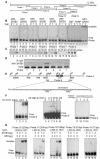Displacement of SATB1-bound histone deacetylase 1 corepressor by the human immunodeficiency virus type 1 transactivator induces expression of interleukin-2 and its receptor in T cells
- PMID: 15713622
- PMCID: PMC549366
- DOI: 10.1128/MCB.25.5.1620-1633.2005
Displacement of SATB1-bound histone deacetylase 1 corepressor by the human immunodeficiency virus type 1 transactivator induces expression of interleukin-2 and its receptor in T cells
Erratum in
-
Correction for Kumar et al., "Displacement of SATB1-Bound Histone Deacetylase 1 Corepressor by the Human Immunodeficiency Virus Type 1 Transactivator Induces Expression of Interleukin-2 and Its Receptor in T Cells".Mol Cell Biol. 2022 Apr 21;42(4):e0004022. doi: 10.1128/mcb.00040-22. Epub 2022 Mar 17. Mol Cell Biol. 2022. PMID: 35297674 Free PMC article. No abstract available.
Abstract
One hallmark of human immunodeficiency virus type 1 (HIV-1) infection is the dysregulation of cytokine gene expression in T cells. Transfection of T cells with human T-cell leukemia type 1 or 2 transactivator results in the induction of the T-cell-restricted cytokine interleukin-2 (IL-2) and its receptor (IL-2Ralpha). However, no T-cell-specific factor(s) has been directly linked with the regulation of IL-2 and IL-2Ralpha transcription by influencing the promoter activity. Thymocytes from SATB1 (special AT-rich sequence binding protein 1) knockout mice have been shown to ectopically express IL-2Ralpha, suggesting involvement of SATB1 in its negative regulation. Here we show that SATB1, a T-cell-specific global gene regulator, binds to the promoters of human IL-2 and IL-2Ralpha and recruits histone deacetylase 1 (HDAC1) in vivo. SATB1 also interacts with Tat in HIV-1-infected T cells. The functional interaction between HIV-1 Tat and SATB1 requires its PDZ-like domain, and the binding of the HDAC1 corepressor occurs through the same. Furthermore, Tat competitively displaces HDAC1 that is bound to SATB1, leading to increased acetylation of the promoters in vivo. Transduction with SATB1 interaction-deficient soluble Tat (Tat 40-72) and reporter assays using a transactivation-negative mutant (C22G) of Tat unequivocally demonstrated that the displacement of HDAC1 itself is sufficient for derepression of these promoters in vivo. These results suggest a novel mechanism by which HIV-1 Tat might overcome SATB1-mediated repression in T cells.
Figures









Similar articles
-
Counterregulation of chromatin deacetylation and histone deacetylase occupancy at the integrated promoter of human immunodeficiency virus type 1 (HIV-1) by the HIV-1 repressor YY1 and HIV-1 activator Tat.Mol Cell Biol. 2002 May;22(9):2965-73. doi: 10.1128/MCB.22.9.2965-2973.2002. Mol Cell Biol. 2002. PMID: 11940654 Free PMC article.
-
Phosphorylation of SATB1, a global gene regulator, acts as a molecular switch regulating its transcriptional activity in vivo.Mol Cell. 2006 Apr 21;22(2):231-43. doi: 10.1016/j.molcel.2006.03.010. Mol Cell. 2006. PMID: 16630892
-
Acetylation-dependent interaction of SATB1 and CtBP1 mediates transcriptional repression by SATB1.Mol Cell Biol. 2009 Mar;29(5):1321-37. doi: 10.1128/MCB.00822-08. Epub 2008 Dec 22. Mol Cell Biol. 2009. PMID: 19103759 Free PMC article.
-
Multiple modes of transcriptional regulation by the HIV-1 Tat transactivator.IUBMB Life. 2001 Mar;51(3):175-81. doi: 10.1080/152165401753544241. IUBMB Life. 2001. PMID: 11547919 Review.
-
Transcellular protein transduction using the Tat protein of HIV-1.Adv Drug Deliv Rev. 2005 Feb 28;57(4):597-608. doi: 10.1016/j.addr.2004.10.011. Epub 2005 Jan 25. Adv Drug Deliv Rev. 2005. PMID: 15722166 Review.
Cited by
-
The 3D enhancer network of the developing T cell genome is shaped by SATB1.Nat Commun. 2022 Nov 14;13(1):6954. doi: 10.1038/s41467-022-34345-y. Nat Commun. 2022. PMID: 36376298 Free PMC article.
-
SATB1-binding sequences and Alu-like motifs define a unique chromatin context in the vicinity of human immunodeficiency virus type 1 integration sites.J Virol. 2007 Jun;81(11):5617-27. doi: 10.1128/JVI.01405-06. Epub 2007 Mar 21. J Virol. 2007. PMID: 17376900 Free PMC article.
-
Harnessing Epigenetics: Innovative Approaches in Diagnosing and Combating Viral Acute Respiratory Infections.Pathogens. 2025 Feb 1;14(2):129. doi: 10.3390/pathogens14020129. Pathogens. 2025. PMID: 40005506 Free PMC article. Review.
-
Hepatitis B Virus X Protein Induces SATB1 Expression Through Activation of ERK and p38MAPK Pathways to Suppress Anoikis.Dig Dis Sci. 2019 Nov;64(11):3203-3214. doi: 10.1007/s10620-019-05681-9. Epub 2019 May 30. Dig Dis Sci. 2019. PMID: 31147803
-
p300-mediated acetylation of histone H3 lysine 56 functions in DNA damage response in mammals.J Biol Chem. 2010 Sep 10;285(37):28553-64. doi: 10.1074/jbc.M110.149393. Epub 2010 Jun 29. J Biol Chem. 2010. PMID: 20587414 Free PMC article.
References
-
- Berger, S. L. 2002. Histone modifications in transcriptional regulation. Curr. Opin. Genet. Dev. 12:142-148. - PubMed
Publication types
MeSH terms
Substances
Grants and funding
LinkOut - more resources
Full Text Sources
Molecular Biology Databases
Research Materials
Miscellaneous
